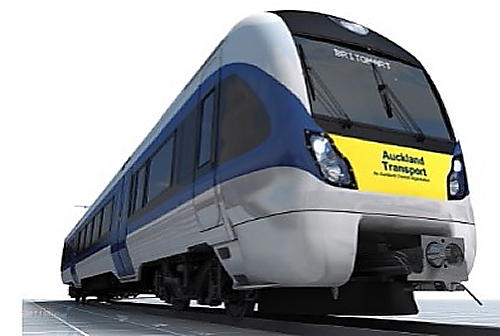CAF liefert 57 Triebwagen nach Neuseeland
 Die neuen Triebwagen für Auckland Transport. Foto: CAF
Die neuen Triebwagen für Auckland Transport. Foto: CAF
[ 24. Oktober 2011 (CAF/Auckland Transport)] Auckland Transport hat mit dem spanischen Schienenfahrzeughersteller CAF (Construcciones y Auxiliar de Ferrocarriles SA) einen Kontrakt über 57 dreiteiligen E-Triebwagen abgeschlossen. Diese sollen Ende 2013 beginnend in der Region Auckland eingesetzt werden. Die Triebwagen für 25 kV/50 Hz werdenältere Triebwagen und lokbespannte Züge ersetzen.
 Die neuen Triebwagen für Auckland Transport. Foto: CAF
Die neuen Triebwagen für Auckland Transport. Foto: CAF
Auckland Transport has signed a contract with Spanish manufacturer, Construcciones y Auxiliar de Ferrocarriles SA (CAF) to purchase 57 three car Electric Multiple Units (EMUs) for the Auckland metropolitan rail network.
The new EMUs will be owned by Auckland Transport (AT) and will come into service from the end of 2013. They will replace the diesel units and diesel locomotive hauled trains currently providing passenger services to commuters in the city.
The trains will incorporate the latest technology in terms of safety, accessibility and modern amenities like on-board Wi-Fi networks. They will be comfortable, quiet, environmentally friendly and attractive.
CAF has also signed a contract to maintain the EMUs until 2026 in a new maintenance facility that Auckland Transport is building at Wiri.
The contract signing concludes a procurement process that began in November 2009 when the government announced that it had agreed to provide a $500m loan to buy 38 new trains and build the new maintenance depot.
Circa NZD$400m of the loan will be used to purchase the trains, while the remainder will be used to build the new maintenance depot.
The procurement was managed on behalf of the government by KiwiRail working closely with the previous Auckland Regional Transport Authority (ARTA) and then transferred to Auckland Transport in preparation for the manufacturing and ownership phases.
The Mayor has welcomed the announcement. “The announcement of this contract is the next step towards giving Auckland a 21st century rail network,” says Len Brown.
“Without electric trains, the extension of that network is not possible. Without electric trains, vital projects like the City Rail Link are not possible.
“It also means that the train network can cope with the extra demand we are already seeing. This is a great deal from every angle.”
“What I’m now looking forward to is riding these trains on a regular basis along with my fellow Aucklanders. They will be a huge advance on the second hand trains Aucklanders have had to put up with for years, and from what I’ve seen they will be spectacular.”
Auckland Transport Chairman Mark Ford, says, “The purchase of the 19 extra trains, 50 per cent more than originally planned, resulted from a positive business case showing the savings involved in operating a homogenous fleet, additional central and local government funding and the intensity of competition providing a very good price.
“It has involved a true collaboration between all of the key stakeholders to reach a common infrastructure goal, a modern fleet of trains for Auckland.
“The key stakeholders involved have been the Ministry of Transport and the NZ Transport Agency, Auckland Council and Auckland Transport. KiwiRail and Auckland Transport have jointly lead the project and headed up the project’s governance structure.
“Auckland Transport and KiwiRail have provided the technical and operational input to the project with support by international experts”, says Mr Ford.
Auckland Council’s Transport Committee Chair Mike Lee says, “Last year, the procurement transitioned from the old Auckland Council structure to the new Super City council structures. During that time there was a change of the local government personnel involved, but all organisations have worked very well together to achieve their common goal – a modern fleet of trains for Auckland with the first train being in service by the end of 2013.
“Although this process was begun by the current government in 2009, the planning for electrification of the Auckland metro network and new electric trains began in the early 2000s.
“The ever increasing popularity of rail commuting is forecast to lift patronage in Auckland to approximately 17 million trips per year by 2016 from 10 million currently. At peak times the fleet of EMUs will operate with six trains per hour from Papakura in the south, on the eastern line and from Swanson on the western line”.
Mr Ford says,” The procurement process caught the attention of a dozen international train manufacturers who responded to the Expressions of Interest document in 2010. From this group, five companies submitted Proposals in response to a detailed RFP process. CAF was selected after a detailed evaluation of the technical and operational proposals based on price and non-price criteria.
“CAF will design its new trains based on the rolling stock that it supplied for the Heathrow Express. Many New Zealanders will be familiar with those trains as visitors to London or as commuters. The difference between these modern units and the current rolling stock used in Auckland will be dramatic and should result in even greater patronage of the network”.
Quelle: CAF, Auckland Transport